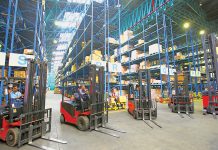The COVID-19 crisis has led airfreight to validate once again its vital role in the global economy and distribution of essential medical supplies. CARGOTALK explores the impact of the virus on the air cargo supply chain of pharmaceuticals and stakeholders’ strategy to ensure continuity of supply worldwide.
Kalpana Lohumi
Air cargo has historically been the optimal choice for high value and sensitive goods like pharmaceuticals and this pandemic has further magnified the importance of this mode of transportation. With the arrival of vaccine, airfreight is again making an important contribution in fighting this pandemic by playing a vital role in the COVID-19 vaccine global supply chain. However, the pandemic has also highlighted the need of updating the pharmaceutical supply chain. When the pandemic first started, people were having trouble in getting the product access and there were airfreight capacity issues because with the sudden restriction on passenger flying, the industry has lost the belly capacity too. But pharmaceutical industry has overcame the situation in such a short span and did relatively well, maintaining drugs on pharmacy shelves. Let’s hear from the industry experts on the impact of the virus on air cargo supply chain of pharmaceutical and logistics requirements.
Sharing the airport scenario, Satyaki Raghunath, Chief Strategy & Development Officer, Bengaluru International Airport (BIAL), says, “COVID-19 had minimal impact on the supply chain of pharmaceutical cargo at BLR Airport, right from the outbreak of the pandemic. During the pandemic, air cargo volumes have witnessed a faster recovery, as compared to passenger traffic. The faster recovery in cargo volumes is largely due to the transport of essential supplies, especially pharmaceutical and medical equipment. The movement of COVID-19 vaccines will give the cargo industry a boost as this potentially life-saving drug is in high demand across the globe. Air cargo will be the only mode of transport that would be able to meet such immediate delivery timelines. As stated by IATA, a large amount of air freighter space would be required for vaccine delivery. However, easing of restrictions on international passenger operations holds the key to longer-term cargo growth. This will also allow for greater belly capacity and the free flow of pharmaceutical products globally.”
Explaining the impact on supply chain due to the uncertain restrictions, Naveen Rao, Founder & Chairman, Sentro Group, shares, “Lockdowns, uncertain restrictions, and different stands of the governments across the globe severely impacted the supply chains. Gaining clarity on various restrictions imposed in various parts of the world is a task as these are locally interpreted and had different meanings altogether. Due to this ever-changing scenario and suspension of regular flight operations, air cargo industry has faced disruption. In order to mitigate the effect on supply chain, many airlines started operating air charter services. Today many airlines have converted passenger aircraft as PTC (passenger to cargo) with or without seats. However, the pharmaceutical industry serves as an essential commodity. Even in tough times like this pandemic, governments are responsible for providing their nationals with adequate quantity and quality of medicine, which pushes all to adapt to new challenges and take it forward. This adaptability to the challenges was the key to success for all the supply chain participants.” In his view, airports, airport authorities, warehouses, airlines, agents, shippers, and consignees have adapted to the challenges slowly and mastered it at all levels – operational, financial & commercial.
Emphasising the fact that pharmaceuticals is one of the verticals which needs a consistent and smooth supply chain always, Vaibhav Vohra, Managing Director, Continental Carriers, stresses, “COVID-19 has caused much disruption to the world in the year 2020. Since the start of the pandemic in early 2020, air travel got obstructed like never before and badly disrupted the pharmaceutical supply chain also. COVID-19 or otherwise, there is always an urgent need for pharmaceutical companies to ensure the delivery of products worldwide. Pharmaceutical supply chain involves lots of complexities and requires logical, realistic and flexible solutions to overcome challenges related to timely distribution of pharmaceutical products. Organised logistics network, digitised supply chain, a high-end tracking system are important aspects for the distribution of pharmaceutical products.”
Adding to these lines, Rao, highlights, “Restrictions and lockdowns created many urgent situations during the early phase of COVID-19. The industry stakeholders have learned how to work in uncertainty and keep the competitive spirit alive, this strategy should continue. COVID-19 presented a unique situation and highlighted the importance of investing in supply chain resilience to build long-term stable operations. The importance of supply chain resilience and risk management is the lesson learnt well by one and all. Today, the industry stakeholders have already prepared well in advance for the vaccine distribution with temperature-controlled warehouses and logistics channels. Civil aviation authorities have already released guidelines on SOPs for carrying vaccine packed in dry ice in temperature-controlled environment. Innovative and economical packaging material has also been introduced to the market to control the temperature with reduced cost.”
“Lack of uniform industry standards for handling pharmaceutical shipments among all the stakeholders is another weak point in the pharmaceutical supply chain. Non-uniform standards lead to time loss as well as hinder optimised use of the cargo capacity of an airline. A resilient pharmaceutical supply chain and sound enterprise decisions call for universal collaboration and coordination efforts from all,” he continues.
According to Rajiv Singh, Managing Director – India, cargo-partner, “Curbs on tourism resulted in a decrease in airfreight capacity due to flight cancellations and this situation led to bottlenecks in the supply chain. He says, “The airfreight industry was more or less able to maintain some strategic routes with passenger aircraft operating as freighter aircraft, also known as pax-to-cargo aircraft. However, the lack of capacity and the inefficiency of such pax-to-cargo aircraft resulted in an increase in airfreight rates.”
Singh stresses on the importance of well-designed supply chain in the industry. He notes, “The COVID-19 situation clearly showed that it is very important to be close to the market and have strong relationships with strategic partners: airlines, trucking companies, manufacturers of temperature-controlled packaging. We as cargo-partner observe the market very closely and prioritise close collaboration with all parties involved in the supply chain. As a global company, we also benefit from the cooperation between our offices around the world, including our network of Pharma Competence Centers – from Mumbai to Vienna.
It has become clear how important well-designed supply chains are and how vulnerable companies are if they underestimate this issue. Beside assets and equipment readiness, contingency planning has also become much more significant. On some trade lanes, ‘Space is Gold’ and we have gone from buyers’ to a sellers’ market in many areas.”
“The crisis has sped up innovation, for example, global customs authorities are moving fast towards digital implementations of their respective processes to minimise paper handling for safety during the COVID-19 pandemic,” says V. Raju, Senior Vice President – CL –Chemical, Pharma & Food Sector, Avvashya CCI, in adding, “Availability and continuity of quality information is key to managing the pharmaceuticals businesses, even prior to the pandemic. Given the highly complex nature of pharmaceutical supply chains, there would not be a one size-fits-all solution. The current unprecedented environment has forced many stakeholders in the supply chain to think differently and focus on the basics. The re-opening of economies will lead to different industries competing for the limited capacity available on aircraft. Given this situation, airlines might adopt a policy ‘go where the money is’ in assigning cargo spaces. Notwithstanding this, there is a continued need to enhance supply chain integrity, improve end-to-end supply chain visibility coupled with seamless handshakes amongst the players in the air cargo supply chain to ensure the timely and effective distribution of pharmaceutical shipments.”
Commenting on the technology part, Rao adds, “Air cargo industry is at a very nascent stage in terms of technology. We need to develop more smart solutions for tracking, monitoring and smooth coordination between various stakeholders of the supply chain. Integration of artificial intelligence and other technologies may present unique opportunities for further supply chain innovation.”
“Another challenge is to achieve air cargo charter costs as low as regular belly flight space, airlines have worked out a formula of transporting mix density cargo to attain better revenue and handling companies have also come forward with reduced handling rates. Although warehousing, loading, unloading building, x-ray costs are still higher,” he adds. Rao is optimistic that with more competition in the segments, the prices will eventually reduce.
COVID-19 Vaccine rollout
The vaccine rollout has begun across the world and India has kicked off a leg in the fight against the pandemic by flying Covishield and Covaxin to different parts of the country. Raghunath shares the challenge in the colossal task of moving vaccine worldwide. He says, “Temperature excursions, lack of adequate infrastructure such as cold chain, cargo supply chain, transparency about the condition of the shipment, availability of cargo space and transportation from port to delivery point are key challenges that need to be addressed. Apart from cold chain and supply chain issues, countries would need to prepare and train their health workforce, deploy digital tracking systems, ensure safety surveillance protocols are in place and undertake community preparedness activities. BLR Airport is equipped to handle smooth processing of vaccines because of its state-of-the-art infrastructure with a temperature-controlled cargo terminal capacity of 60,000 MTPA and 25 dedicated cold storage rooms with adjustable temperature ranges from -25 to +25 degree Celsius.”
“The industry could face a shortage of airfreight capacity, especially for certain key corridors where vaccines are being produced as well as hub locations where vaccines are stored,” says Singh, in adding “Already a challenge is the lack of dry ice and the safety procedures around producing dry ice, hence several stakeholders in the supply chain are now planning to produce dry ice. The product integrity of vaccines must be maintained throughout the supply chain to ensure patient safety. This requires a great deal of infrastructure to be in place. Especially challenging is the vaccine from Pfizer which needs to be stored and transported at a temperature of -70 °C. Final leg delivery to hospitals and storage at hospitals is critical as most countries’ cold chain infrastructure is not built around
such temperatures.”
Singh further lists a set of challenges:
The temperature requirements are also affected by extreme weather conditions and the complexity of routings for the vaccines. In order to move such large quantities, there will be potential shortages of certain equipment and issues with the positioning of empty equipment.
Beside the pharmaceutical industry, we also have to consider all other industries involved in vaccine distribution, who will also be heavily challenged for supply, such as glass vial producers, the packing industry or the labelling industry.
Special planning, secured loading & protection throughout the movement
“Vaccine distribution is certainly going to be a challenging task. Vaccine supply and distribution is quite a complex process which requires a temperature-controlled atmosphere throughout the shipping process, starting from the manufacturing unit until the delivery point. Presently, cold chain networks are concentrated in the big cities and towns. To fill this gap we need enough cold chain trucks, freighters and a good freight management scenario. A good number of planes, trucks, warehouses and health centres will need to be outfitted with freezers, so air cargo rates and capacity would be another challenge. We just cannot ignore the risk factor and security concerns involved in logistics for the vaccines. Vaccine logistics would require special planning, secured loading and protection throughout its movement,” shares Vohra.
Continuing on ideal temperature required for the storage and movement of vaccine, Raju adds, “Temperature mistakes are mostly due to inappropriate shipping procedures in the cold chain, and these losses are estimated at US$34.1 billion annually. But that number does not even take into account the cost – physically as well as financially – of any illnesses that could have been prevented by timely deliveries of high-quality vaccines. With billions of vaccines needed to address the pandemic, a high spoilage rate would result in an immense financial loss and a huge delay in vaccinations that could result in deaths and a longer global shutdown.”
“Different vaccines may require different temperatures and different handling procedures. Hence, staff throughout the cold chain would need different training on how to handle each vaccine. Airports and logistics companies are currently evaluating whether they can meet this need. The results remain to be seen. These are just a few of the major problems and potential solutions, but there are dozens of interesting scenarios that could arise. And finally, it’s possible that with the airline companies reeling from the pandemic, there might not be enough active planes to meet the demand for shipping these vaccines. Preparing and fortifying the cold chain for vaccine distribution will ensure that vaccines are not wasted and will help the world get through this pandemic sooner,” he adds.
General cargo gets the backseat
Putting stress on such an important concern, Singh points out, “We can see difficult challenges for ‘general cargo’ in getting space and allocation agreements since many carriers are much focused on the moving of vaccines, putting the general cargo somehow in the background, resulting in the repositioning of aircraft to cover the demand and the cancellation of existing allocations and agreements.”
Keeping cost under control
Highlighting the pricing part, Rao adds, “Most important for the vaccine is temperature- controlled transportation at an affordable price. Keeping costs under control and maintaining high-quality temperature-controlled transportation and warehousing are key factors for moving vaccine worldwide. Delivering billions of doses of a vaccine that must be transported and stored in a deep-frozen state to the entire world efficiently, will involve hugely complex logistical challenges across the supply chain. Air cargo plays a crucial role in the distribution of vaccines in usual days. But, for COVID-19 vaccines, we need a well-established global time- and temperature-sensitive distribution systems.”
Logistics service providers’ requirements from the shippers
When asked about the service providers’ requirements from the shipper, Vohra says, “The vaccine distribution cost will be measured based on the volume of vaccine and location based demand which is still not cleared by any of the shippers. Also, there is uncertainty on how and when the global rollout will happen.”
Product integrity needs to be maintained throughout the supply chain in the vaccine transportation. “To ensure this, the shipper and manufacturer must provide the required product stability data, information around the product, demands around temperature requirements, humidity control etc. There has to be an agreed Standard Operating Procedure (SOP), where critical control points are identified. These critical control points form a Route Risk Assessment. These assessments are normally made by service providers, presented and signed off by the shipper. Accordingly, shipper and manufacturer must have persons in charge of shipping who connect with logistics service providers. Given the global challenges relating to transport capacity, it is also essential to plan transport schedules very carefully,” explains Singh.
On the other hand, Rao stresses, “Adaptability to new challenges, keeping cost-effective service and quality of services is vital as vaccine is temperature-controlled commodity. Deficiency in quality of service will lead to serious consequences, users’ health will be at stake.”
Collaboration allows ease of work
According to Rao, “Collaboration is crucial because we need some facilities on a large scale like temp-controlled warehouses and logistical channels. These once developed with heavy investments may not be utilised later and may lead to zero returns in the coming days. Hence, collaboration with existing supply chains with less pressure can act as a saviour for the industry, which can reduce cost and eliminate heavy investment to overcome this pandemic and the crisis which it will leave.”
“Supply chain is directly impacted by instabilities in demand and supply. The risk of supply interruptions can only be avoided if the challenges faced by the industry are addressed comprehensively. In the current scenario, horizontal collaboration among stakeholders in the exiting supply chain would allow greater ease of work and cooperation towards accomplishing a common goal, thereby overcoming innumerable challenges,” expresses Raghunath.
Pharmaceutical supply chain before and after the pandemic
“From a technical and industry-oriented point of view, the industry has always had a clear understanding of how the transport and supply chain must function. But now, the industry stakeholders are coming together in order to overcome the new challenges. There are more open partnerships now between different service providers, carriers, packing providers, local warehouse providers. The pandemic has created a more open and transparent global supply chain. The pandemic is not only a challenge, but also a chance for the airfreight industry to drive global standards, like the CEIV, and set up better infrastructure for temperature-controlled cargo at the airports. Before COVID-19, there was basically no public perception of a temperature-controlled supply chain, or it was at least very limited, while now, this topic is the primary focus. At the end of the day, every individual will benefit from this development as anybody could be a patient,” states Singh.
“Several vulnerabilities were exposed during the COVID-19 pandemic in the pharmaceutical supply chain, mostly due to a lack of coordination among the various stakeholders. Complete and ongoing supply chain risk assessment, forecasting and planning will be vital going forward. Greater automation and implementation of digital technologies will be equally important to enable true networking and data sharing and maintaining transparency across the entire supply chain which was neglected earlier,” voices Raghunath.
Adding to these lines, Vohra enlightens, “This outbreak of pandemic has exposed the weaknesses of the logistics industry. It showed that there is an urgent need to give out of the box solutions and traditional supply chain approaches might no longer be relevant. Logistics companies who have invested in technologies and believe in providing flexible, timely & effective quality solutions embedded with transparency will be the winners.”
“With vaccine rollover, demand for many medicines will reduce, leading to new challenges for pharmaceutical companies and their supply chains,” notifies Rao. Calling it one of the short-term effects of COVID-19, Rao further explains, “Due to the pandemic, the sale of certain medicines used for symptomatic treatment has increased manifold. People may have bought medicines to keep in their homes but not consumed them. It has boosted the sales manifold.
Similarly, for the pharmaceutical supply chain, pressure for fast delivery in a temperature-controlled environment is enormous. There is a need for developing infrastructure to accommodate this influx in demand. Once the target is achieved, there may be a gap in supply and requirement. It may lead to financial disasters for some companies, who
may not be able adapt to new business models with new challenges and opportunities.”














